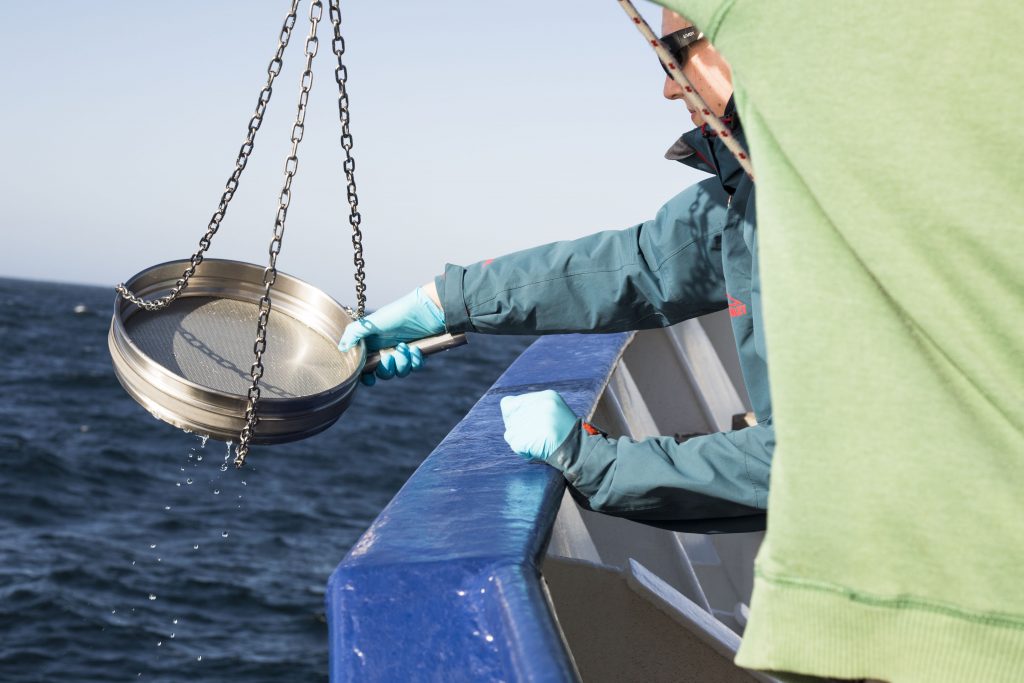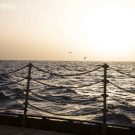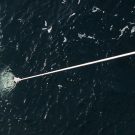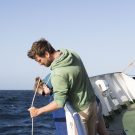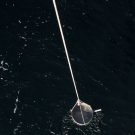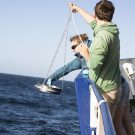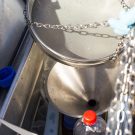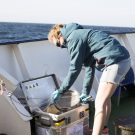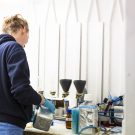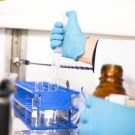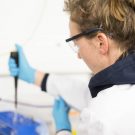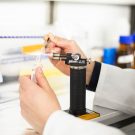The week is starting onboard POSEIDON. Slowly the sun rises, immersing the sea for a brief moment in orange-red light. Eight o’clock. The work on the deck and in the laboratories is going on. The day begins with the measurement of the microstructure sonde, followed by the CTD. In addition to this station work, so-called underway measurements take place regularly during the expedition.
On the boat deck, in front of the wet laboratory, there is a shaft that goes directly into the water. At the beginning of the expedition, a pump was installed in this shaft, which continuously transports seawater from a depth of approximately 5 to 6 meters to the wet laboratory. This water passes through various devices, where water temperature, CO2, N2O, CO and O2 content, as well as chlorophyll is measured. These measurements are continuous and recorded by computers. In addition, so-called underway samples are taken several times a day. These are water samples taken from the water being pumped through from the shaft into the wet laboratory. These samples are taken for the determination of nutrients, chlorophyll and various gases. Most of the samples are used to study the gas exchange between the ocean and the atmosphere. Furthermore, air samples are taken at the monkey island, the top deck, to investigate climate-relevant trace gases. Air is compressed with a pump in a metal canister. These samples will be analyzed on shore after the expedition.
The light intensity is also recorded on the monkey island. This value is relevant for Theresa, who deals with the surface microlayer of the ocean and the development of chlorophyll. Since light has an influence on the formation of phytoplankton and is likely to influence the accumulation processes of relevant substances, it is important to record this value daily.
“Theresa is sifting water,” is the answer you get when looking for Theresa in the morning or in the afternoon. In fact, she stands at the bow twice a day and samples water with the help of Melf. The water remains in the mesh of a screen and is collected in bottles. As a result, samples of the microlayer of the ocean are collected. What they are interested in are so-called surfactants, surface-active substances that are located on the uppermost water layer, the surface microlayer. These substances can dampen capillary waves. Capillary waves are small waves that are on the surface of big waves. These small waves increase the surface area of the ocean and allow more gas exchange. If these capillary waves are now damped by the surfactants, the surface becomes smoother and therefore has smaller surface area, with the result that less gas exchange takes place. Moreover, organic substances are able to influence gas diffusivity directly. In the laboratory, Theresa filters for example the water she has sampled and stains it with various dyes that give a clue to the amount of proteinaceous substances or substances that consist of polysaccharides, also called transparent exopolymer particles. Then the filters with the substances are examined under the microscope. This allows conclusions to be drawn about the amount of these substances in the microlayer. In comparison, underway water samples are taken and examined as a control. Using DNA methods, the different species are investigated. Since different influences on the surface, such as UV radiation, occur, the species differ. The species, e.g. plankton, found in the microlayer are called Neuston. In the end, all the different parameters analyzed are compared to the abundance of surfactants to determine their evolution in the uppermost water layer.
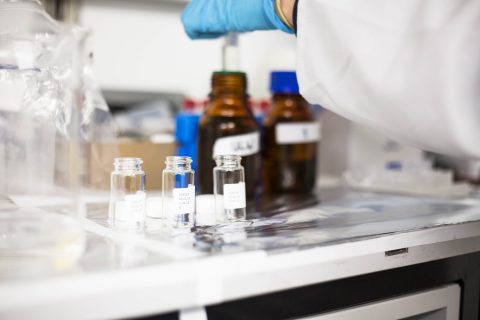
Processing of the water samples in the lab. Verarbeiten der Wasserproben im Labor. (Credit: Lisa Hoffmann, CC BY-NC-ND)
Wochenanfang auf der POSEIDON. Langsam geht die Sonne auf. Taucht das Meer für einen kurzen Augenblick in orange-rotes Licht. Acht Uhr. Auf den Decks und in den Laboren wird schon fleißig gearbeitet. Der Tag beginnt mit der Messung der Mikrostruktur-Sonde, dann folgt die CTD. Neben diesen Messstationen finden während der Fahrt permanent sogenannte Underway-Messungen statt.
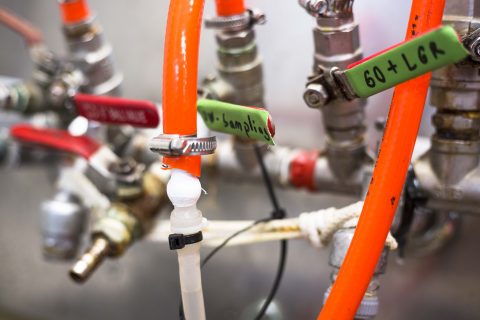
The underway sample tubes in the wet lab. Die Schläuche für die underway-Messungen im Nasslabor. (Credit: Lisa Hoffmann, CC BY-NC-ND)
Auf dem Bootsdeck, vor dem Nasslabor, befindet sich ein Schacht, der direkt ins Wasser geht. In diesem Schacht wurde zu Beginn der Fahrt eine Pumpe installiert, die permanent Seewasser aus ungefähr 5 bis 6 Meter Tiefe ins Nasslabor transportiert. Diese Wasser läuft durch verschiedene Geräte, in denen die Wassertemperatur, CO2, N2O, CO und O2 Gehalt, sowie Chlorophyll gemessen wird. Diese Messungen laufen permanent und werden von Computern aufgezeichnet. Daneben werden mehrmals am Tag sogenannte Underway-Proben genommen. Das sind Proben, die von dem Wasser, dass durch den Schacht ins Nasslabor gepumpt wird, genommen werden. Hier werden Proben zur Bestimmung von Nährstoffen, Chlorophyll und Gasen genommen. Ein Großteil der Underway-Messungen dient der Untersuchung des Gasaustausches zwischen dem Meer und der Atmosphäre. Außerdem werden oben auf dem Peildeck Luftproben genommen, um klimarelevante Spurengase zu untersuchen. Dabei wird über eine Pumpe Luft in einem Metallkanister komprimiert. Dieser wird im Anschluss an die Fahrt an Land analysiert.
Oben auf dem Peildeck wird zudem die Lichtstärke aufgeschrieben. Dieser Wert ist relevant für Theresa, die sich mit der Oberflächenschicht des Ozeans und der Entwicklung von Chlorophyll beschäftigt. Da Licht (also die UV-Strahlung) einen Einfluss auf die Bildung von oberflächenaktiven Substanzen hat, ist es wichtig täglich diesen Wert zu erfassen.
„Theresa siebt Wasser,“ ist die Antwort, die man bekommt, wenn man morgens oder am Nachmittag nach Theresa sucht. Tatsächlich steht sie zweimal am Tag am Bug und schöpft mit Hilfe von Melf Wasser. Dieses bleibt in den Lamellen eines Siebes hängen und wird dann in Flaschen aufgefangen. Dadurch sammelt sie Proben der Oberflächenschicht. Was sie dabei interessiert sind sogenannte Surfactans, oberflächenaktive Substanzen, die sich auf der oberen Wasserschicht, dem Interface zwischen Wasser und der darüber liegenden Atmosphäre befinden. Diese Substanzen dämpfen Kapillarwellen. Kapillarwellen sind kleine Wellen, die sich auf der Oberfläche der großen Wellen befinden. Durch diese kleinen Wellen wird die Oberfläche des Ozeans vergrößert und es kann mehr Gasaustausch stattfinden.
Im Labor filtert Theresa das geschöpfte Wasser und färbt es mit verschiedenen Farbstoffen, die einen Anhaltspunkt für proteinhaltige Substanzen oder Substanzen geben, die aus Polisaccharinen (mehrkettige Zucker) bestehen, auch transparente exopolimere Partikel genannt. Anschließend werden die Filter mit den Substanzen unter dem Mikroskop untersucht. Dort wird die Anzahl der Partikel berechnet. Dadurch kann ein Rückschluss über die Anteile an der Oberfläche gemacht werden. Im Vergleich dazu werden Underway-Wasserproben untersucht, die diese Stoffe nicht beinhalten. Auch werden in DNA-Untersuchungen die verschiedenen Arten angeschaut. Auch hier findet ein Vergleich zu Underrway-Proben aus 5 bis 6 Meter Tiefe statt. Da an der Oberfläche andere Einflüsse, wie UV-Strahlung vorherrschen, unterscheiden sich die Arten. Man spricht von Noiston, für Arten von der Oberfläche und von Plankton bei Arten, die unter der Oberfläche vorkommen.
